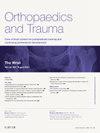Special considerations for major trauma in pregnancy and childhood
Q4 Medicine
引用次数: 0
Abstract
Managing trauma in pregnant women and children is challenging due to their unique anatomical and physiological features. This paper aims to explore the special considerations needed for trauma management in these vulnerable populations, emphasizing the need for patient-centred approaches. Trauma in pregnancy involves a balance between maternal and fetal well-being, requiring adjustment to resuscitation protocols, to tailor for the maternal physiological changes during pregnancy, and continuous fetal monitoring with the collaborative help of neonatologists and obstetricians. The challenges in paediatric trauma are focused on avoiding long-term developmental defects, especially after growth plate injuries that may lead to limb discrepancies, or complete growth arrests. This requires age-specific interventions and a robust rehabilitation strategy to minimize long-term complications following trauma. This paper also highlights the importance of simulation-based learning and medico-legal understanding for orthopaedic trainees. Future studies should focus on optimizing maternal and fetal health following trauma, with a focus on delivery methods, and creating innovative strategies to minimize long-term outcomes in paediatric patients. Understanding the unique nature of these vulnerable populations allows the clinician to respond effectively, optimizing the outcomes and trauma care.
妊娠期和儿童期重大创伤的特殊考虑
由于孕妇和儿童独特的解剖和生理特征,处理创伤是具有挑战性的。本文旨在探讨创伤管理需要在这些弱势群体的特殊考虑,强调需要以病人为中心的方法。妊娠创伤涉及到母婴健康的平衡,需要对复苏方案进行调整,以适应妊娠期间孕产妇的生理变化,并在新生儿学家和产科医生的协同帮助下对胎儿进行持续监测。儿科创伤的挑战集中在避免长期发育缺陷,特别是在生长板损伤可能导致肢体差异或完全生长停止后。这需要针对年龄的干预措施和强有力的康复策略,以尽量减少创伤后的长期并发症。本文还强调了模拟学习和医学法律理解对骨科学员的重要性。未来的研究应侧重于优化创伤后的母婴健康,重点关注分娩方法,并制定创新策略,以尽量减少儿科患者的长期后果。了解这些弱势群体的独特性质使临床医生能够有效地做出反应,优化结果和创伤护理。
本文章由计算机程序翻译,如有差异,请以英文原文为准。
求助全文
约1分钟内获得全文
求助全文
来源期刊

Orthopaedics and Trauma
Medicine-Orthopedics and Sports Medicine
CiteScore
1.00
自引率
0.00%
发文量
57
期刊介绍:
Orthopaedics and Trauma presents a unique collection of International review articles summarizing the current state of knowledge and research in orthopaedics. Each issue focuses on a specific topic, discussed in depth in a mini-symposium; other articles cover the areas of basic science, medicine, children/adults, trauma, imaging and historical review. There is also an annotation, self-assessment questions and a second opinion section. In this way the entire postgraduate syllabus will be covered in a 4-year cycle.
 求助内容:
求助内容: 应助结果提醒方式:
应助结果提醒方式:


